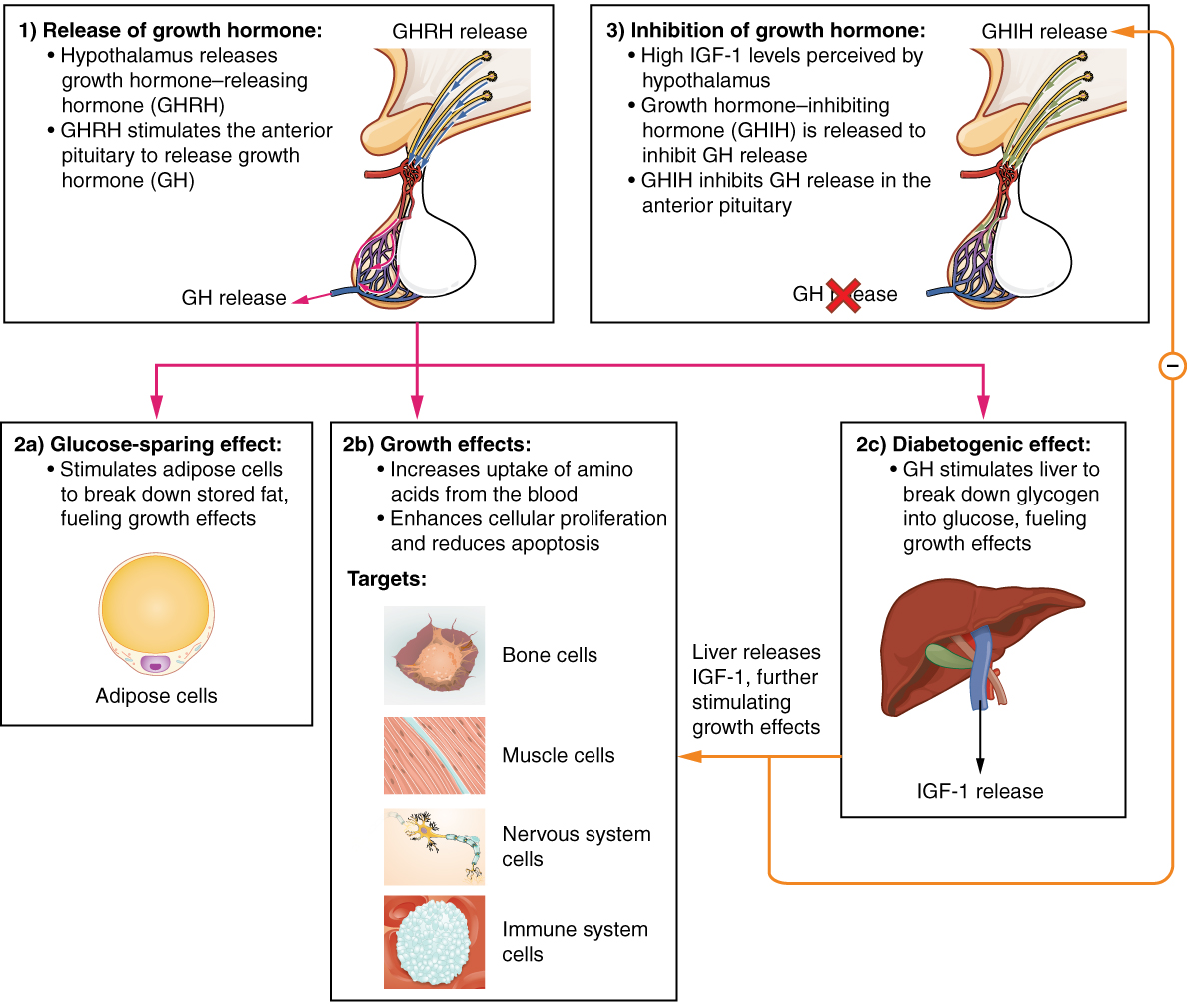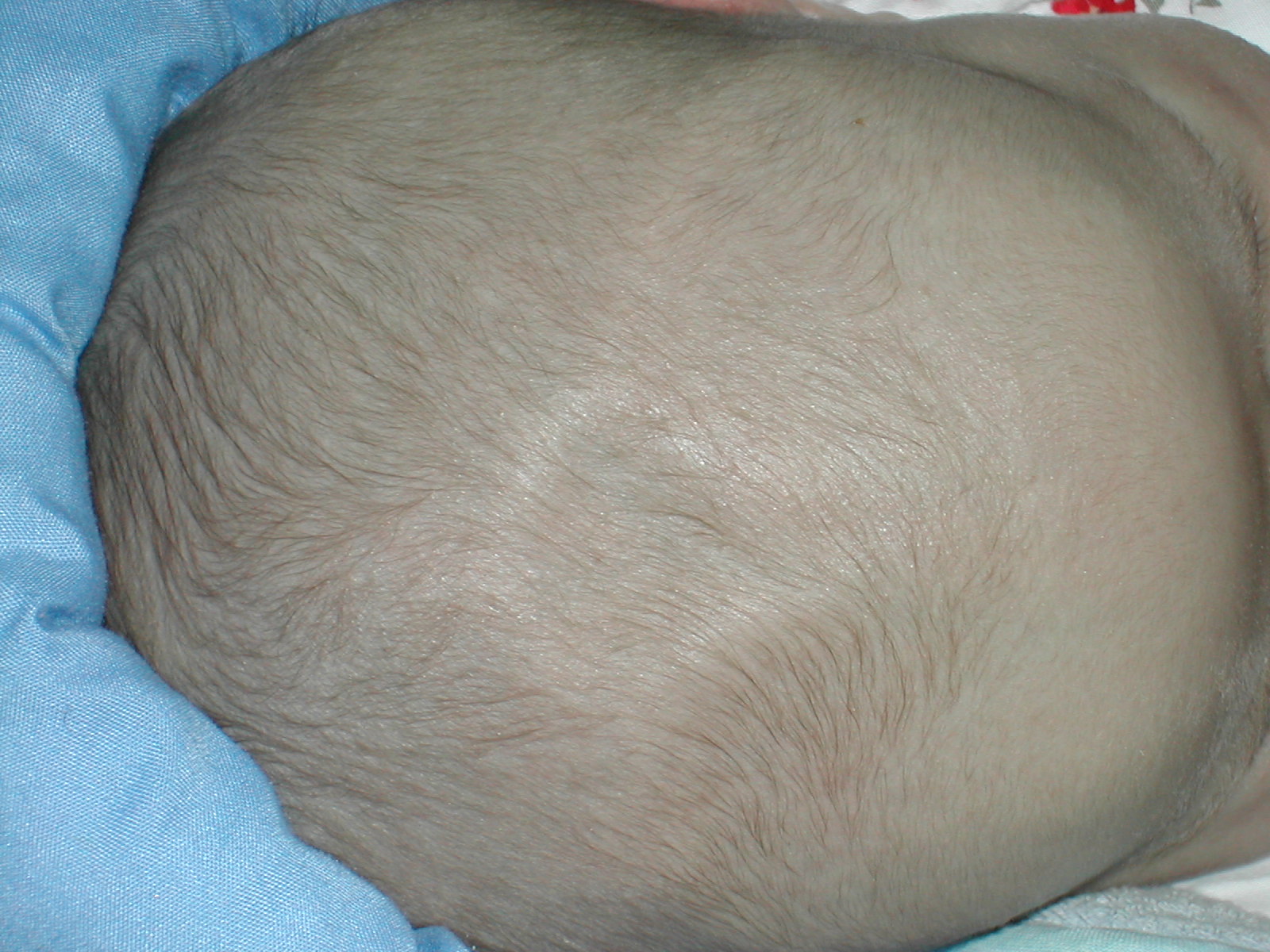|
Acromegaly
Acromegaly is a disorder that results in excess growth of certain parts of the human body. It is caused by excess growth hormone (GH) after the growth plates have closed. The initial symptom is typically enlargement of the hands and feet. There may also be an enlargement of the forehead, jaw, and nose. Other symptoms may include joint pain, thicker skin, deepening of the voice, headaches, and Visual impairment, problems with vision. Complications of the disease may include type 2 diabetes, sleep apnea, and high blood pressure. Signs and symptoms Features that may result from a high level of GH or expanding tumor include: * Headaches * Enlargement of the hands, feet, nose, lips, and ears, and a general thickening of the skin * Soft tissue swelling of internal organs, notably the heart with the attendant weakening of its muscularity, and the kidneys, also the vocal cords resulting in a characteristic thick, deep voice and slowing of speech * Generalized expansion of the skull at ... [...More Info...] [...Related Items...] OR: [Wikipedia] [Google] [Baidu] |
Somatostatin Analogue
Somatostatin, also known as growth hormone-inhibiting hormone (GHIH) or by several other names, is a peptide hormone that regulates the endocrine system and affects neurotransmission and cell proliferation via interaction with G protein-coupled somatostatin receptors and inhibition of the release of numerous secondary hormones. Somatostatin inhibits insulin and glucagon secretion. Somatostatin has two active forms produced by the alternative cleavage of a single preproprotein: one consisting of 14 amino acids (shown in infobox to right), the other consisting of 28 amino acids. Among the vertebrates, there exist six different somatostatin genes that have been named: ''SS1'', ''SS2'', ''SS3'', ''SS4'', ''SS5'' and ''SS6''. Zebrafish have all six. The six different genes, along with the five different somatostatin receptors, allow somatostatin to possess a large range of functions. Humans have only one somatostatin gene, ''SST''. Nomenclature Synonyms of "somatostatin" include: ... [...More Info...] [...Related Items...] OR: [Wikipedia] [Google] [Baidu] |
Skull Bossing
Skull bossing is a descriptive term in medical physical examination indicating a protuberance of the skull, most often in the frontal bones of the forehead ("frontal bossing"). Although prominence of the skull bones may be normal, skull bossing may be associated with certain medical conditions, including nutritional, metabolic, hormonal, and hematologic disorders. Frontal bossing Frontal bossing is the development of an unusually pronounced forehead which may also be associated with a heavier than normal brow ridge. It is caused by enlargement of the frontal bone, often in conjunction with abnormal enlargement of other facial bones, skull, mandible, and bones of the hands and feet. Frontal bossing may be seen in a few rare medical syndromes such as acromegaly – a chronic medical disorder in which the anterior pituitary gland produces excess growth hormone (GH). Frontal bossing may also occur in diseases resulting in chronic anemia, where there is increased hematopoiesis and enl ... [...More Info...] [...Related Items...] OR: [Wikipedia] [Google] [Baidu] |
Growth Hormone
Growth hormone (GH) or somatotropin, also known as human growth hormone (hGH or HGH) in its human form, is a peptide hormone that stimulates growth, cell reproduction, and cell regeneration in humans and other animals. It is thus important in human development. GH also stimulates production of insulin-like growth factor 1 (IGF-1) and increases the concentration of glucose and free fatty acids. It is a type of mitogen which is specific only to the receptors on certain types of cells. GH is a 191-amino acid, single-chain polypeptide that is synthesized, stored and secreted by somatotropic cells within the lateral wings of the anterior pituitary gland. A recombinant form of HGH called somatropin ( INN) is used as a prescription drug to treat children's growth disorders and adult growth hormone deficiency. In the United States, it is only available legally from pharmacies by prescription from a licensed health care provider. In recent years in the United States, some health ... [...More Info...] [...Related Items...] OR: [Wikipedia] [Google] [Baidu] |
Endocrinology
Endocrinology (from ''endocrine system, endocrine'' + ''wikt:-logy#Suffix, -ology'') is a branch of biology and medicine dealing with the endocrine system, its diseases, and its specific secretions known as hormones. It is also concerned with the integration of developmental events proliferation, growth, and differentiation, and the psychological or behavioral activities of metabolism, human development (biology), growth and development, tissue (biology), tissue function, sleep, digestion, Respiration (physiology), respiration, excretion, mood (psychology), mood, Stress (physiology), stress, lactation, Motor coordination, movement, reproduction, and sensory perception caused by hormones. Specializations include behavioral endocrinology and comparative endocrinology. The endocrine system consists of several glands, all in different parts of the body, that secrete hormones directly into the blood rather than into a Duct (anatomy), duct system. Therefore, endocrine glands are regarde ... [...More Info...] [...Related Items...] OR: [Wikipedia] [Google] [Baidu] |
Human Mandible
In jawed vertebrates, the mandible (from the Latin ''mandibula'', 'for chewing'), lower jaw, or jawbone is a bone that makes up the lowerand typically more mobilecomponent of the mouth (the upper jaw being known as the maxilla). The jawbone is the skull's only movable, posable bone, sharing joints with the cranium's temporal bones. The mandible hosts the lower teeth (their depth delineated by the alveolar process). Many muscles attach to the bone, which also hosts nerves (some connecting to the teeth) and blood vessels. Amongst other functions, the jawbone is essential for chewing food. Owing to the Neolithic advent of agriculture (), human jaws evolved to be smaller. Although it is the strongest bone of the facial skeleton, the mandible tends to deform in old age; it is also subject to fracturing. Surgery allows for the removal of jawbone fragments (or its entirety) as well as regenerative methods. Additionally, the bone is of great forensic significance. Struct ... [...More Info...] [...Related Items...] OR: [Wikipedia] [Google] [Baidu] |
Hyperhidrosis
Hyperhidrosis is a medical condition in which a person exhibits excessive perspiration, sweating, more than is required for the Thermoregulation, regulation of body temperature. Although it is primarily a physical burden, hyperhidrosis can deteriorate the quality of life of the people who are affected, frequently leading to psychological, physical, and social consequences. Hyperhidrosis can lead to difficulties in professional fields, with more than 80% of patients experiencing moderate to severe emotional effects from the disease. This excess of sweat happens even if the person is not engaging in tasks that require muscular effort, and it does not depend on the exposure to heat. Common places to sweat can include underarms, face, neck, back, groin, feet, and hands. It has been called by some researchers 'the silent handicap'. Both ''diaphoresis'' and ''hidrosis'' can mean either ''perspiration'' (in which word sense, sense they are synonymous with ''sweating'') or ''excessive per ... [...More Info...] [...Related Items...] OR: [Wikipedia] [Google] [Baidu] |
Hyperpigmentation
Hyperpigmentation, also known as the dark spots or circles on the skin, is the darkening of an area of Human skin, skin or nail (anatomy), nails caused by increased melanin. Causes Hyperpigmentation can be caused by sun damage, inflammation, or other skin injuries, including those related to acne vulgaris.James, William; Berger, Timothy; Elston, Dirk (2005). ''Andrews' Diseases of the Skin: Clinical Dermatology''. (10th ed.). Saunders. . People with darker skin tones are more prone to hyperpigmentation, especially with excess sun exposure. Many forms of hyperpigmentation are caused by an excess production of melanin. Hyperpigmentation can be diffuse or focal, affecting such areas as the face and the back of the hands. Melanin is produced by melanocytes at the lower layer of the epidermis. Melanin is a class of pigment responsible for producing color in the body in places such as the eyes, skin, and hair. The process of melanin synthesis (melanogenesis) starts with the oxidation ... [...More Info...] [...Related Items...] OR: [Wikipedia] [Google] [Baidu] |
Hypertrichosis
Hypertrichosis (sometimes known as werewolf syndrome) is an abnormal amount of hair growth over the body. The two distinct types of hypertrichosis are generalized hypertrichosis, which occurs over the entire body, and localized hypertrichosis, which is restricted to a certain area. Hypertrichosis can be either congenital (present at birth) or acquired later in life. The excess growth of hair occurs in areas of the skin with the exception of androgen-dependent hair of the pubic area, face, and axillary regions. Several circus sideshow performers in the 19th and early 20th centuries, such as Julia Pastrana, had hypertrichosis. Many of them worked as freaks and were promoted as having distinct human and animal traits. Classification Two methods of classification are used for hypertrichosis. One divides them into either generalized versus localized hypertrichosis, while the other divides them into congenital versus acquired. Congenital Congenital forms of hypertrichosis are ... [...More Info...] [...Related Items...] OR: [Wikipedia] [Google] [Baidu] |
Macroglossia
Macroglossia is the medical term for an unusually large tongue. Severe enlargement of the tongue can cause cosmetic and functional difficulties in speaking, eating, Dysphagia, swallowing and sleeping. Macroglossia is uncommon, and usually occurs in children. There are many causes. Treatment depends upon the exact cause. Signs and symptoms Although it may be asymptomatic, symptoms usually are more likely to be present and more severe with larger tongue enlargements. Signs and symptoms include: * Dyspnea – difficult, noisy breathing, obstructive sleep apnea or airway obstruction * Dysphagia – difficulty swallowing and eating * Dysphonia – disrupted speech, possibly manifest as lisping * Sialorrhea – drooling * Angular cheilitis – sores at the corners of the mouth * Crenated tongue – indentations on the lateral borders of the tongue caused by pressure from teeth ("pie crust tongue") * Open bite malocclusion – a type of malocclusion of the teeth * Mandibular prognathis ... [...More Info...] [...Related Items...] OR: [Wikipedia] [Google] [Baidu] |
Fontanelle
A fontanelle (or fontanel) (colloquially, soft spot) is an anatomical feature of the infant human skull comprising soft membranous gaps ( sutures) between the cranial bones that make up the calvaria of a fetus or an infant. Fontanelles allow for stretching and deformation of the neurocranium both during birth and later as the brain expands faster than the surrounding bone can grow. Premature complete ossification of the sutures is called craniosynostosis. After infancy, the anterior fontanelle is known as the bregma. Structure An infant's skull consists of five main bones: two frontal bones, two parietal bones, and one occipital bone. These are joined by fibrous sutures, which allow movement that facilitates childbirth and brain growth. * Posterior fontanelle is triangle-shaped. It lies at the junction between the sagittal suture and lambdoid suture. At birth, the skull features a small posterior fontanelle with an open area covered by a tough membrane, where the two pa ... [...More Info...] [...Related Items...] OR: [Wikipedia] [Google] [Baidu] |
Vocal Cords
In humans, the vocal cords, also known as vocal folds, are folds of throat tissues that are key in creating sounds through Speech, vocalization. The length of the vocal cords affects the pitch of voice, similar to a violin string. Open when breathing and vibrating for speech or singing, the folds are controlled via the recurrent laryngeal nerve, recurrent laryngeal branch of the vagus nerve. They are composed of twin infoldings of mucous membrane stretched horizontally, from back to front, across the larynx. They vibration, vibrate, modulating the flow of air being expelled from the lungs during phonation. The 'true vocal cords' are distinguished from the 'false vocal folds', known as vestibular folds or ''ventricular folds'', which sit slightly superior to the more delicate true folds. These have a minimal role in normal phonation, but can produce deep sonorous tones, screams and growls. The length of the vocal fold at birth is approximately six to eight millimeters and grows t ... [...More Info...] [...Related Items...] OR: [Wikipedia] [Google] [Baidu] |
Headache
A headache, also known as cephalalgia, is the symptom of pain in the face, head, or neck. It can occur as a migraine, tension-type headache, or cluster headache. There is an increased risk of Depression (mood), depression in those with severe headaches. Headaches can occur as a result of many conditions. There are a number of different classification systems for headaches. The most well-recognized is that of the International Headache Society, which classifies it into more than 150 types of Primary headache disorder, primary and secondary headaches. Causes of headaches may include dehydration; fatigue; sleep deprivation; Stress (biology), stress; the effects of medications (overuse) and recreational drugs, including withdrawal; viral infections; loud noises; head injury; rapid ingestion of a very cold food or beverage; and dental or sinus issues (such as sinusitis). Treatment of a headache depends on the underlying cause, but commonly involves analgesic, pain medication (esp ... [...More Info...] [...Related Items...] OR: [Wikipedia] [Google] [Baidu] |








